In this talk moderated by Gadi Shamia, COO of Talkdesk, Dan Steinman, Chief Customer Officer at Gainsight, discusses the myriad of ways Sales and Customer Success are intertwined in SaaS companies. As Dan points out, Customer Success is a fairly new role in SaaS organizations and figuring out how the two can harmoniously exists and support each other is still a work in progress.
Dan kicks off the session challenging the audience to consider whether all departments should report to Customer Success, he then dives into how Customer Success can help you objectively assess the quality of the leads that are in the pipeline, why you shouldn’t try to squeeze as much money as you can out of the initial deal, or why customer success people should think like salespeople. This session will definitely make you consider the ways Sales and Customer Success teams function within your own organization.
Check out the full transcript below! You can view Dan’s slides here.
If you want to see more sessions from 2016, we’re releasing a new one each week. Subscribe here to be notified. And be sure to grab your tickets to the 2017 Annual NOW.
TRANSCRIPT
Gadi Shamia: We’re switching gears. We talked about selling through the enterprise. We’re going to have two sessions about customer success.
I’m really, really happy to have Dan Steinman here. Not only he has been in customer success for forever, he’s also working for the company of customer success, which is Gainsight. They’re building the tools that enable customer success to happen.
For whoever just joined and don’t know me, my name is Gadi Shamia. I’m the chief operating officer at Talkdesk. We make call center software that companies use for sales, like Box or Cloudera, that uses it for the SDR team, or companies like DoorDash, and others that use it for customer service.
Most of our customers are in customer service. They use our product to provide voice support to their customers so definitely a huge topic of interest for us.
With this, Dan, I would like you to say a few words about yourself. I did a little bit of research about you and I went to this Twitter tool that looks for how many times you mention specific words on Twitter.
I just wanted to make sure that you really care about customers. Your most popular word on Twitter you used was “Customer,” dead on.
Dan Steinman: Amen.
Gadi: Second was “Success.”
Dan: Amen, again.
Gadi: You also use “Awesome” a lot, and then “Congrats.”
Dan: That’s because it endears me to my CEO when I say that, because that’s his favorite word.
Gadi: And are you a golfer?
Dan: Yes, I am a golfer.
Gadi: You do tweet about golf as well. Now you know a little bit more about Dan. You have a few slides, so how about you take it from here.
Dan: I’m going to stand up if nobody minds. How many are here to talk about customer success? Raise your hand. How many are here to listen to somebody else talk about customer success?
[laughter]
Dan: Thanks for coming. I have one more poll question for Jason which I’ll pass on. This is the third day of SaaStr. Raise your hand if you wish it was four days long. Wow, pretty cool. I thought everyone would be out having a drink already.
I’ll apologize in advance, because when the makeup person did my makeup, I asked her if she could make it look like I have more hair and apparently she failed at that. Here I am to talk about customer success.
I’m the Chief Customer Officer at Gainsight. Probably if you’re here to talk about customer success, there’s a good chance you’ve heard about Gainsight. I’m not going to talk about Gainsight, just some general things around customer success. In particular, because they let me pick my topic, I picked the topic that I get asked about the most often, which means probably 10 to 15 times a week.
That is “How do you balance sales and customer success?” Because the SaaS world has changed almost everything.
One of the things that it’s changed that I think everybody intuitively gets, but I haven’t heard a lot of people say it concretely, and that is we used to live in a world that was pre sales and post sales.
The dividing line between those was pretty obvious, but the SaaS world and the subscription economy in general has changed that dramatically, where we now today live in a world that is acquisition and retention.
Those sound like those things are the same as pre and post sales, but they’re really not, because in the world we live in today, acquisition is obviously sales and marketing, and sales engineering, and things like that. All of those things exist in the retention part of the business as well, because we now live in a world where the sales motion never ends.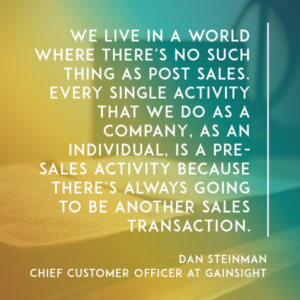
I like to say it this way. We live in a world where there’s no such thing as post sales. Every single activity that we do as a company, as an individual, is a pre sales activity, because there’s always another sales transaction, whether it’s an actual renewal, or an opt out option for customers every month, depending on your business model.
That, conceptually, changes things a lot, because in the acquisition world, obviously, sales marketing and SC stuff, but in the retention part of the world those same things have to happen. Sales has to continue to happen, which means that marketing has to continue to happen.
To a certain degree that sales engineering function, not necessarily the same people, has to continue to happen as well, so, that changes a lot of things. The question I get asked all the time is, “How do you balance sales and customer success, given that the sales motion is an ongoing thing that never ends?”
I’ll talk about that for a few minutes, give you a few maybe provocative things to think about. Gadi is going to jump in occasionally and throw a question at me that he thinks is something that’s probably on your mind, so give me a few minutes to talk my way through this. This is the question.
“How do you balance sales and customer success in this world, where now we have multiple people touching our customers?” There’s salespeople. There’s customer success. There’s support. There’s services, etc. We have to live with this tension that in the customer’s mind there’s too many people that are touching them, and it often boils down to this question.
The customer doesn’t ask this question a lot, but as customer success people, we have to deal with this all the time. “How do you deal with that ongoing sales motion in your world?” This is not news to anybody, but I want to just set this up.
That is, the good old days, not that long ago, we lived in this world where there’s this thing called a funnel, was actually a funnel, lots of activity to put things into the top of the funnel, lots of technology applied to that world in the form of Salesforce and marketing automation tools, like Marketo and Eloqua, etc., and then post sales stuff.
There was technology down there and there was attention paid to the post sales stuff, but it was almost all reactive kinds of things and not a lot of technology, some technology to do case tracking and things like that but not a lot. Today’s world is very different. This is absolutely 100 percent not a funnel, it is indeed an hourglass and I think I would argue very strongly that the bottom part of that hourglass is way bigger than the top part.
Because if you think about lifetime value for customers, if I sell you a contract for $25,000 and you pay that upfront for a one year contract, my expectation of your lifetime value is probably at least 10 times that big, because I would expect you to renew that contract 7 or 8 times and I would expect you to have your contract value go up five percent a year or something like that, because you’re buying more or just because I’m reducing your discount, whatever the reason might be.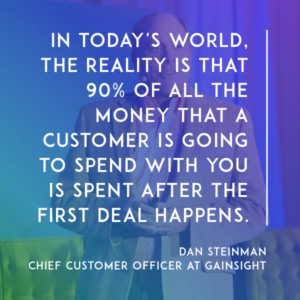
The reality is 90 percent of all the money that you’re going to spend with me is spent after the first deal happens. If we go backwards 20 years to a world where we were all in the enterprise software world, like Oracle and SAP and everybody else, that’s the opposite. We used to sell software with the expectation that 80 to 90 percent of all the money we were ever going to collect from you gets collected at the time of the first deal.
Everything changes and we create this hourglass which needs this continual sales motion along with the customer success piece of it, to get our customers to adopt, to buy more, and to renew their contracts and this is an ongoing cycle. We’ve dramatically changed the way that world works. I think most of you guys get that.
I already said this, there really is no such thing as post sales and there’s also a focus now on not always being reactive. That part of the world that used to be called post sales was almost always reactive. Today there’s a movement, a strong movement, in the customer success world to make that much more proactive.
The answer to that initial question, “How do you balance sales and customer success,” is the wrong question, because it’s not about balancing them, it’s about collaboration. Those two teams need to work together in some way, shape, or form.
If there’s an ongoing renewal process in your install base, whether your customer success people do it with their sales hat on or you have a different person doing it who is a sales person, this isn’t balancing sales and customer success, it’s combining them. One way to think about it is that customer success plays the sales the sales engineering role to the sales guy after that initial sale is done.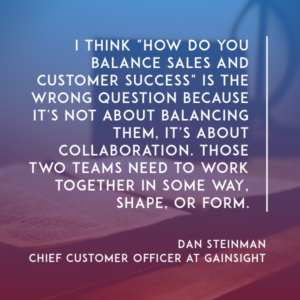
What I mean by that is…think about what an SE does for a salesperson typically. What they do is everything necessary to help the sales guy close the deal, technical conversations, demos, engage with the IT people, whatever those things might be. The job description of customer success people is the same job description, what do you do? Everything necessary to make sure the next sales transaction can happen.
That next sales transaction might be a renewal or an upsell but the motion is the same. The world that we live in where sales continues, marketing has to continue, and that sales engineering function continues, too, in a very different way but the CSM or the Customer Success people really take on that role of sales engineer by enabling and empowering the customer to do what we want them to do, which is renew their contract and buy more stuff from you.
If we take the term customer success seriously, then the question is what do successful customers do? They do two tangible things, one is they renew their contracts at a high rate and they buy more stuff from you, so that’s got to be the goal of customer success to enable that to happen, so the world’s not about balance, it’s really about cooperation and collaboration.
Here’s a question then since we’re talking about sales and customer success. A couple of questions and I’ll give you my thoughts on it and Gadi may jump in with some questions about it, too.
If we live in this world where sales and customer success are living together in harmony and cooperating and collaborating to make customers successful, then how should, or if customer success should influence new acquisitions and sales? We know they’re going to influence existing customers and the ongoing sales motion there, but should customer success influence new acquisition as well and if so, how would they do that?
I’ll let you ponder that for a second while I just throw the other question out there and that is how do you handle those sales transactions that happen after the initial deal? We all believe they’re sales transactions and renewal is a sales transaction and upsell is a sales transaction, so how do we handle that?
Do we hand it over to customer success, do we let them do it. Do we have sales people in the customer success world? How do we make that happen? We’re talking about both of these questions. I’ll throw out a couple of thoughts and if you guys have questions on this, I’ll be here afterwards or you can shout them out or Gadi can assume that he knows what you’re thinking.
On the first question, “Should customer success influence new acquisition sales,” The answer is clearly yes. In one way, for sure, we got to create advocacy within our install base and that changes the new acquisition part of the function because you have to have referenceable customers. That’s an easy answer to that question.
A more complex answer is, “Should customer success actually influence specific deals that are in the pipeline,” i.e., “Should customer success have veto power over deals that are in the pipeline because they think that we can’t make those customers successful?” That’s a really extreme position. I know people who can do that. VPs of customer success who can veto deals in the pipeline, but it’s a pretty interesting question to ponder and what does it mean?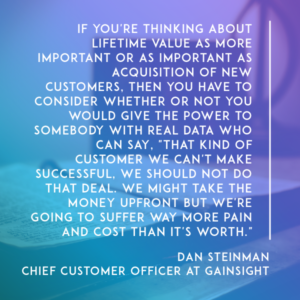
What it means is if we’re really thinking about lifetime value more important or at least as important as acquisition of new customers, then should we actually give the power to somebody not just anecdotally but with real data who can say, “That kind of customer we can’t make successful, we should not do that deal. We might take the money upfront but we’re gonna suffer way more pain and cost than it’s worth doing.”
One question, right? See if I can remember the other question…how to handle sales transactions after the initial deal, lots of different ways to do this. I’ll just give you a couple of thoughts.
One is CSMs do renewals. They have the relationship with the customer, they’re working with them all along, easy for them to do that transaction. Logical assumption, not necessarily true because the renewal can very much be a sales process. It can be a resell in a lot of cases.
Oftentimes, you’ll get to renewal time and the customer will say, “Well. I’m not really sure if I’m getting all the value that I should be getting out of your product and not sure it’s worth what I paid for it.” That often generates a bit of a sale cycle.
It might be a mini sale cycle, it could actually be a major sale cycle, in which case you could argue that a customer success manager isn’t the right person to do that job because they’re not typically oriented towards sales, they’re not salespeople. In a lot of cases they’ve specifically chosen to not be salespeople. Asking them to do something that’s a sales transaction or a sales job might be the wrong thing to do.
We’re thinking about that, and then the other question is if in that situation does the customer success manager try to do it and if they need help, can they ask for sales to come back in. If the answer to that is yes, then you’d better pay that salesperson for the effort to do that resell because they won’t do things like that unless they’re getting paid for it.
There’s lots of different models that work, but this is something that you need to think about. If you’re going to do customer success and be serious about it, you got to think about who has responsibility for those ongoing sales transactions? Should it be the customer success team, or should there be a sales team that only focuses on your install base, or should they just be able to call on your account execs and bring them back into the fray when needed?
Gadi: Listen, Dan, I want to flip this question looking from the eyes of the customer for a second because we all talk about what we want to do, but there are customers on the other side. I’m wondering as a customer…I’m talking with Betty from customer success for the whole year.
She walked me through the implementation, she helped me when the product was down, she runs quarterly reviews with me and tells me what my business goals and help me optimize the product further. She brings the right people when I…to talk about roadmap. Coming renewal time, all of a sudden she calls Jerry or whoever to close the deal, and Jerry comes there bare of any knowledge of the account and just do the sales abracadabra and close the deal.
How do I feel, the customer being handed over to this other guy they don’t have a relation with because…by the way, he’s new, he just joined six months ago? I actually bought from Steve. How do they feel the customers this way, is it the most effective way to actually continue win this business from the customer?
Dan: It’s a really good question and so I think that process would probably be wrong. The way that you would think about it if you’re going to have a different person do the sales transaction, then that is one of the many resources that the customer success person can bring to bear to make that account successful.
A CSM operates much like a sales guy and I tell my CSMs, “Pretend and act like every single person in the company works for you because they do. You can call on anyone at any time to come and help you with a particular customer all the way up to the CEO, and in the right situation the CEO will get involved in that deal, so all the resources in the company are at your disposal.”
Now, one of those resources is the guy who will do the paperwork because CSMs typically don’t want to do that. If they’re playing quarterback, they have the relationship with the customer, they have every right to say to the customer, “Hey, it’s 90 days before your renewal. I just wanted to remind you that it’s coming up and I wanted to introduce you to Joe, who’s gonna take you through the paperwork process because I hate paperwork,” or however you want to position it.
What the CSM wants to do is retain their trusted advisor status and a trusted advisor doesn’t include negotiating price and redlining contracts and things like that. They have the opportunity, if you set it up right, to be quarterback who brings that salesperson in and then, if necessary, they can also play good cop, bad cop in that situation.
“I’m the good guy, I’m here only to help you. I’m sorry our sales guy wants five percent more out of you, but that his world and I’m just here to help you use our product better.” Oversimplified but that’s the world we often live in.
Gadi: One more question. During the life of the contract, one of the advantages of the CSM is that they talk with the customer constantly so they’re better than a sales team in identifying upsell opportunity. How do you train your CSMs to identify those upsell opportunities? It’s almost more relevant to your life at life at Marketo than the life in Gainsight because it’s such a specific team you’re working with.
Dan: Yeah, it’s actually pretty similar, both Marketo and Gainsight. There’s a number of follow on products and licenses in the Gainsight world, not so much follow on products, but licenses that are valuable to other parts of the business, not just customer success people, but marketing people, people who have ongoing sales responsibilities, support people, etc.
It’s really important. The customer success people need to know the product inside and out, even as the product gets more complex, because they should be the lead generation engine for upsells and cross sells into the install base. They should be the ones sniffing it out.
What I say to my CSMs, I’m not going to ask you to be a salesperson, but I am going to ask you to be sales savvy because every single day you are talking to a customer, you should be thinking about, “Is there something else this customer needs from us that costs money, i.e., product or services?”
It is incumbent upon them to figure that out, to be knowledgeable enough to know what the right questions are to ask that leads us down that path. Because I’ll tell you just how we do it at Gainsight, we hired a salesperson, we put them on the customer success team and put them on quota, and said, “You will do all renewals and all upsells.”
That person is collaborating every day with a CSM who’s bringing them leads. Here’s a customer who has 20 licenses, but nobody on their marketing team is using our product. Let’s talk to them. I’ll get you introduced and you can take it from there.
The reverse is true. The sales guy is getting ready to do a renewal, he wants to know what he’s walking into, who’s he going to talk to? The CSM. Tell me what’s going on with his accounts so I know what’s going to happen when that person picks up the phone. Is he going to be angry at me? Does he love us? Does he need more stuff that we have to sell? There’s that coordination that has to happen.
I think that that becomes part and parcel of the job, is the CSMs, even if they’re not sales people, they got to be thinking sales all the time and they should be generating a ton of leads and handing them over, if that’s how you do it, to the sales guy, or executing on themselves, if that’s what you expect them to do.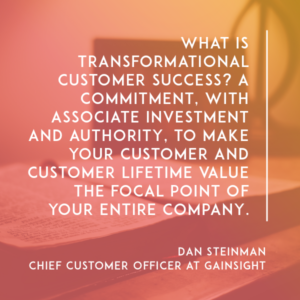
I want to talk just for a minute, because these things tie in about what I call transformational customer success. This is a little bit theoretical, but pretty interesting if you think about it. What is transformational customer success? A big fancy word. Commitment with associate investment and authority to make your customer and customer lifetime value the focal point of your entire company.
Think about what that would mean. If customer lifetime value or the customer was actually the focal point of every single organization in the company, what if your org chart, instead of looking like this, with customer success being the organization over there that takes care of our customers, I’m glad they’re there, they’re really smart, they’re good people, and everything that rolls downhill ends up there.
That’s how a lot of people think about customer success. It’s this catch all thing that saves customers whenever possible.
I’m going to just fast forward here through this, in a world where there’s these maturity curves and you advance your customer success world to the transformation piece of this? Oftentimes, it starts thinking about adoption then it evolves towards retention where upsell becomes more of the equation, and then expansion where you’re doing upsell, cross sell, advocacy, all of those things matter.
Optimization is when you start to refine the efficiency of that organization. Then transformation is this theory I’m talking about right now, which is, how do we allow customer success to change the entire company? What if your organization looked like this?
This is philosophical. I’m not suggesting that you actually change your org chart and everyone reports to customer success, but what would happen philosophically if the main priority of every single organization was the success of our customers?
It would create a really, really interesting world and I could go through each one of these, which I won’t do, but I am going to talk about the sales part of this, because I think in the SaaS world, in the subscription world, in a world where the focal point is customers and customer success, some things have to be different in the acquisition part of the world.
What if it looked like this? What if sales really was thinking about customer lifetime value and retention as their major priority? There’s a few things that we would think about potentially doing differently. This is a really, really interesting question. Fifteen years ago, in the enterprise software world, this question was really easy to answer.
Should we maximize the initial deal with every customer? Yes. Every single time, we should get every penny we possibly can, because that’s 90 percent of the deal or 90 percent of all the business we’re ever going to do with that customer. Let’s maximize it, toss it over the wall, let the post sales people take care of it.
In the SaaS world, in the subscription world, I think it’s a really interesting question to ponder. Should we maximize the initial deal with all of our customers? I’m going to argue that the answer to that is probably not. You have to be careful about the answer to this question, because you don’t want to take this too far and say to your sales guys, “Keep the deal small.” That’s not the point here. We don’t want to keep deals small.
But think about this process. I sign a 12 month deal with you as my customer. I sell you a thousand licenses, knowing that the likelihood of you being able to absorb all thousand of those licenses is pretty small. I get to the 12 month date, it’s time for renewal. We worked really hard, we did a great job, we’ve got 600 of those licenses deployed.
Guess what happens at the renewal transaction? They’re going to give us back 400 licenses or 300 maybe, but some number is going to come back to us, which means down sell. We sign this contract for a million bucks upfront. Renewal time comes, we do the renewal for $700,000. That’s not good for anybody, except for the sales guy who got their commission on the million dollars and it’s in the bank and they’re driving their Porsche and maybe even work for somebody else now.
The customer success team who’s responsible for retention and held accountable for that, and metriced and goaled and paid on that now suddenly has to take a $300,000 down sell, not because they didn’t their job, but because we oversold the initial deal.
Take that same situation. I’m going to argue that instead of ending the year with 600 licenses and we got 400 back, we would be better off if we sold 200 up front and another 300 during the year to end at 500. Even though that’s a smaller number than the 600, we’re better off having landed and expanded because morale is better, nobody got dinged because of the down sell, the investors love us because we really do land and expand from 200 to 500 licenses, pretty nice growth in a year.
Even though we end at a number that’s smaller than what we did in the other model, I’m going to argue that that process is better, the customer success people feel better about it, and everyone in the company probably feels better about it, except maybe that sales guy who’s really not going to do anything differently except maybe his target is slightly different. We don’t force them to maximize every deal.
These are really hard questions. This is a really, really challenging question to figure out how to answer, but we need to at least think about it. All I’m saying here is we should be thinking about that.
Gadi: I’ll make one quick comment. Many companies choose now to allow the salesperson, even if they’re in a hunter mode only, to keep their account for X number of months so they are not forced to sell the 400 licenses. They can actually wait and see, see how things are working. They can still get commission even if they add 100 users three, four months in.
This is one way to deal with that, because sales people always want to get their commission in the end. This is what you always have to remember. You can tell them whatever you want. They want to get their commission. One way is just let them continue to hold their account for a little bit longer so they can grow with it at least at the beginning.
Dan: That’s a really good point, Gadi. That is one of the models that starts to alleviate this challenge. Another one is just pay the sales guy on the renewal. If it’s a down sell, then you have to claw something back. These are challenging things, but there are some ways to mitigate this. I think the thing I’m trying to do is just to get people thinking about this.
We’re so ingrained in the old days where let’s just get every dollar we can out of our deals in the initial deal. I just don’t think that’s the right way.
Second question is one I’ve already addressed. Should customer success have veto power? Ultimately, you could give that power, but you got to be careful with it, because if it’s not used properly, what it does is it just starts to narrow your TAM. Let’s just say no to every customer who isn’t a perfect fit. Good. We just narrowed our TAM down to 11 companies in the world. Probably not a great idea.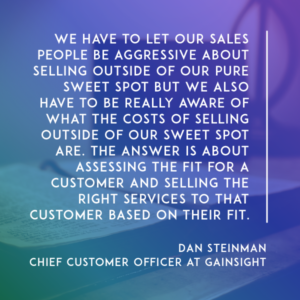
We have to let our sales people be aggressive about selling outside of our pure sweet spot, but we do also have to be really aware of what the costs of selling outside of our sweet spot are. Ultimately, the answer isn’t about veto power. The answer is about probably assessing the fit for a customer and selling the right services to that customer based on their fit.
If it’s outside of our sweet spot and we know it’s going to be a challenge for a number of reasons, we don’t sell them our $10,000 implementation package, we sell them our $50,000 implementation package. That way, the services people are made whole. They can make some money off of that deal, the extra effort is paid for by the customer, and we’re more likely to make the customer successful, because we’re not trying to cut corners and speed up that onboarding project.
Gadi: Dan, we have three more minutes. You have one more bullet point.
Dan: Got one more. Then the last one, I already touched on a little bit too. Can customer success help objectively assess deals that are in a pipeline? The answer over time has to be “Yes,” because we should be doing a lot of pattern matching. Every customer in this industry with these use cases, at this discount level has failed. Maybe it’s not every customer, 80 percent of them have churned.
If we can start to pattern match customers in the pipeline or prospects in the pipeline with customers that have either succeeded or failed, then we can help objectively assess the pipeline. Over time customer success people and tools should be able to put some kind of a risk score onto every deal that’s in the pipeline because of pattern matching with other customers.
Volume companies have a big advantage here, because they have way more customers to assess and to pattern match. Over time, customer success ought to be helping to do that.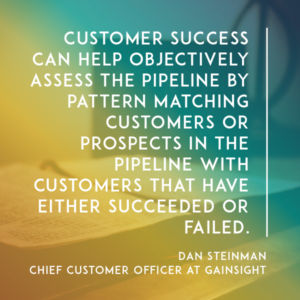
One of the other things I want to point out here is that there is a power shift that’s happening in our companies or maybe happened before your company started, depending how young you are. The idea that sales rules the roost is just not as true as it used to be. I’m not taking anything away from sales. That’s a really hard thing to do. We should celebrate it every time it happens, super important.
But by the natural order of things in a SaaS or subscription world, the retention part of the business gets to be more important financially and in other ways as well than the acquisition part of the business. The example I’ll use is Salesforce, the most mature SaaS company of all, next year it will be approximately a 10 billion dollar business for them. 8 billion of that 10 billion is going to come out of their install base.
If you’re the CFO at Salesforce and you’re trying to do next year’s forecast, who are you going to spend more time with? The retention guy with the an $8 billion number or the acquisition guy with the $2 billion number. Pretty easy question to answer. This isn’t because somebody is trying to grab power, although they could be. It’s just the natural order of SaaS.
It’s why Wall Street thinks that the SaaS model is so valuable, to the reason Salesforce is a $50 billion company market cap essentially without ever having turn profit.
It’s because they know that install base is extremely valuable. In fact, for all of us who run SaaS companies, sooner or later, the way our investors are going to look at our company is, what is your install base worth if that was a standalone company? If you’re at Salesforce, the answer is, it’s an $8 billion business, growing at 25 or 30 percent a year, probably within 80 percent gross margin.
It’s a pretty good business, anyone want to be a CEO for that company? I do. That’s a really good business. That’s what’s everyone’s banking on in the SaaS world that we’re all going to get there. This shift is happening inside of our companies from sales to customer retention.
Gadi: Because we’re out of time, let’s allow for a couple of questions. Before the mics are getting to people who want to ask questions, ask you one quick one. In your team or in previous teams, what are the three, four key KPIs you measure your customer success team against and pay them bonuses for?
Dan: Great question. So I think about customer success the same way a VP of sales thinks about sales. Ultimately, there’s only one number that matters if you’re managing sales people and that is how much did you sell.
There’s a whole bunch of things that lead to that occurrence. A good sales guy does a lot of things that you want to measure on a monthly basis but you only pay for one thing and I think about customer success pretty much the same way.
There’s one number that matters and that’s net retention, which is the combination of renewal minus churn plus upsell, because every single thing we do as customer success people should be driving our customers in the direction of loyalty and loyal customers renew their contracts at high rates and they buy more stuff. Net retention is the key number.
Now you have to measure a couple of other things, so this doesn’t get out of whack because net retention can mask other problems. You could have a bad overall renewal rate like 60 percent of your customers are renewing their contract, 40 percent are churning but there’s a whole bunch of upsell in those 60 percent that makes our net retention look good at 110 percent and you don’t want to mask the fact that you have a really challenging churn situation if 40 percent of your customers are going away.
I think you need to measure three things, gross renewal rate, which is percentage of customers that renew; net retention, which is the combination of renewal and upsell; and the gap between those. If that gap gets too wide then you’ve got something fundamentally wrong with one part of your business.
Gadi: Two rapid-fire questions.
Audience Member: You talked about retention between the sales reps who maximize the deal with his customer success to maximize customer success, which usually takes time and deliberation. What is your opinion on multi-year agreements with reduced pricing target through the years, which allows the company to focus on the customer success in the long run?
Dan: Yeah. This is a great question, what’s with my opinion on multi year deals. This is a really hard question. I have a little bit of an opinion that multi-year deals are dangerous because they don’t force us to focus on the customer in the same way we have to, if we do annual deals.
The caveat I’ll put on that is, that you have to take in consideration how hard your product is to implement. If your product takes more than 90 days realistically to implement then you should probably start stretching towards two year contracts, because there is a high correlation between the time it takes for a customer to get value and the likelihood of their renewal.
If you have a one year contract and it takes 11 months to get up and running, the likelihood of your renewal is definitely lower than if it only took three months. If you’re stretching those numbers too close together, you should start thinking about multiyear deals.
Also if you have the choice, multiyear deals have some danger built into them. It’s easy to take the customer for granted, “Oh, let’s not worry about them, they’re not a high priority, because their renewal isn’t for two and half years.”
Wrong attitude. You’re not to get more upsells if you’re treating customers that way. Almost all these questions have a double edge sword. Multi-year deals are good and necessary if implementation is long, but there is some danger associated with it as well.
Gadi: I think we have…last question.
Audience Member: Right over here. Thanks, Dan. That was a great presentation. It’s actually a hot topic for us at Lupio. How do you feel about a threshold based approach, where up to a certain amount of licenses or upgrade the CSM can still be managing that and then pass that threshold, you pass it off to the sales rep because up to a certain amount it seems fairly transactional and how do you structure something like that?
Dan: The ultimate big answer is, this is one of those situations and I know some CEOs hate this, where double comp makes sense, CSM’s who get comped as a team on net retention, which takes into account every renewal and upsell whether they’re involved or not.
At the same time you want to ease the customer’s experience. If a customer calls me, I’m the CSM and says, “Hey Dan, I need five more licenses. I know what our price was on the last order. Let’s go with that.” There’s no reason for me to call a sales guy. It just messes up the customer experiences, inefficient internally.
You have to give your CSM’s the ability to ask for help from sales guys when that makes the most sense and just make sure they’re not compensated to try to be a hero and try to do a sales deal that they’re really not qualified or capable of doing.
The way to do that is double comp. We’ll do it if it’s easy and if it’s not easy, I’m going to get paid for it anyway, so I’m going to get my sales guy to come in and do it. There’s some danger in throwing everything over the wall, but I think smart people will figure out where those lines are drawn.
Gadi: I don’t think we have more times for question, but it was terrific. Thank you very much, Dan.
Dan: Thank you.
You can view all of Dan’s slides here.
